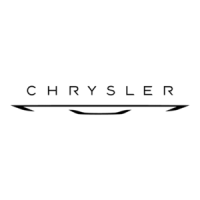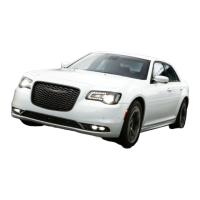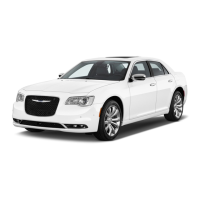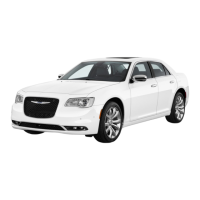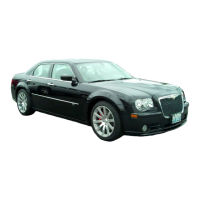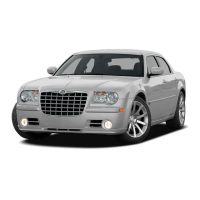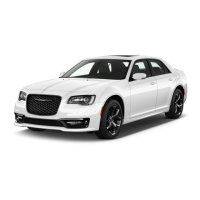
Do you have a question about the Chrysler 300 and is the answer not in the manual?
| Brand | Chrysler |
|---|---|
| Model | 300 |
| Category | Automobile |
| Language | English |
Guides on navigating the manual and understanding its contents and symbols.
Highlights critical warnings and cautions for safe vehicle operation.
Details on the location and importance of the Vehicle Identification Number (VIN).
Information and warnings regarding vehicle modifications and alterations.
Explains the keyless ignition system, key fob, and ignition switch operations.
Details on the Sentry Key® Immobilizer system preventing unauthorized vehicle operation.
Information on how to arm, disarm, and rearm the vehicle security alarm system.
Covers locking/unlocking doors, trunk, and using the panic alarm.
Instructions and conditions for using the remote starting system.
Explains manual and power door lock operation, including child-protection locks.
Details on the passive entry system for locking/unlocking doors without using buttons.
Information on power windows, including auto-down and anti-pinch features.
Describes how to release the trunk lid from inside and outside the vehicle.
Covers seat belts, SRS air bags, and child restraints for occupant safety.
Provides essential safety advice for passengers, exhaust gas, and general vehicle use.
Details on automatic dimming, power, heated, illuminated, and tilt mirrors.
Explains the BSM system using radar sensors to detect vehicles in blind spots.
Information on power seats, lumbar support, heating, ventilation, and head restraints.
Covers programming memory features for seat, mirrors, pedals, and steering column.
Details on headlight switch, automatic headlights, and time delay features.
Instructions for intermittent wipers, mist feature, washers, and rain-sensing wipers.
Guides on activating, setting, and deactivating electronic speed control.
Information on ACC operation, activation, speed settings, and following distance.
Details FCW system providing audible/visual warnings and potential braking.
Explains LaneSense operation, warnings, and turning the system on or off.
Covers ParkSense® sensors, warning display, and enabling/disabling the system.
Information on the ParkView® camera, guidelines, and delay features.
Details on courtesy/reading lights, sunglasses storage, and sunroof switches.
Instructions for programming HomeLink® buttons and troubleshooting.
Guides on operating the sunroof and power shade, including express and manual modes.
Information on 12-volt power outlets, USB ports, and fuse locations.
Details on front and rear cupholders, including heated and cooled options.
Covers glove compartment, console features, and door storage areas.
Information on trunk mat, grocery bag hooks, and cargo nets.
Details on the rear window defroster and power sunshade operation.
Overview of instrument panel components and controls.
Diagram and description of the instrument cluster gauges and indicators.
Detailed explanations of warning lights, indicators, and gauges.
Explains DID features, menus, and control buttons for accessing vehicle information.
Instructions on how to set the analog clock located on the instrument panel.
Guides for accessing and changing customer programmable features via touchscreen and faceplate.
Covers pre-start checks, keyless entry, normal starting, and cold weather procedures.
Details on transmission control, gear selector, and shift interlock systems.
Explains the driver-interactive transmission feature for manual shift control.
Information on the active on-demand AWD system for optimal traction.
Safety advice for acceleration and traction on slippery road conditions.
Cautions and warnings for driving through flowing, rising, or shallow standing water.
Details on the electric power steering system and selectable steering efforts.
Instructions on applying and releasing the foot-operated parking brake.
Overview of the dual hydraulic brake systems and their performance.
Explains ABS, TCS, BAS, ESC, HSA, Ready Alert Braking, and Rain Brake Support.
Covers tire markings, identification numbers, terminology, and loading information.
Provides information on tire pressure, fuel economy, tread wear, and ride comfort.
Guidance on timely tire rotation to improve tread life and traction.
Explains TPMS operation, low pressure warnings, and service warnings.
Importance of maintaining correct tire inflation for high-speed driving.
Recommendations for using radial ply tires and warnings against mixing tire types.
Criteria for tire repair and replacement guidelines for run-flat tires.
Information on all-season, summer, and snow tires.
Guidance on the use and limitations of compact spare tires.
Information on full-size spare tires and replacement recommendations.
Warnings and limitations for using limited-use spare tires.
Precautions for using traction devices to avoid vehicle damage.
Details on recommended gasoline octane ratings for 3.6L and 5.7L engines.
Information on cleaner-burning gasoline and its benefits for emissions and air quality.
Cautions regarding the use of gasoline blends containing methanol or high ethanol.
Information for Non-Flex Fuel Vehicles using E-85 fuel, including potential symptoms.
Manufacturer recommendations regarding gasoline containing MMT additive.
Information on detergent additives in gasoline and the need for extra additives.
Guidelines for maintaining vehicle performance and avoiding fuel system damage.
Precautions to prevent carbon monoxide poisoning from exhaust gases.
Covers E-85 general information and fuel requirements specific to FFV vehicles.
Details on E-85 fuel composition and warnings about ethanol vapors.
Information on fuel consumption and driving range when using E-85 fuel.
Guidance on using ethanol-compatible service components for FFVs.
Cautions regarding fuel system components and ethanol mixtures.
Step-by-step instructions for opening the fuel filler door and refueling.
Procedure for opening the fuel filler door in case of malfunction.
Information on load carrying capacity shown on the Vehicle Certification Label.
Defines GVWR and warnings about exceeding it.
Defines GAWR and emphasizes even load distribution.
Explains how overloading affects vehicle components and safety.
Safety tips and limits for towing, including warranty coverage requirements.
Definitions of trailer towing terms like GVWR, GTW, and GCWR.
Industry standards for trailer hitch classes and maximum towing weights.
Chart showing maximum trailer weight ratings towable by engine/transmission.
Guidance on proper trailer loading and tongue weight for vehicle stability.
Explanation of weight-distributing systems for heavier loads and sway control.
Procedures and restrictions for recreational towing of the vehicle.
Information on acceptable towing methods for AWD and RWD models.
Instructions on using hazard warning flashers for emergency signaling.
Steps to reduce overheating potential, including highway and city driving actions.
Details on proper lug nut/bolt torque for wheel mounting.
Critical warnings and procedures for safely changing a tire.
Steps to prepare the vehicle and surroundings before jacking.
Detailed instructions on the process of lifting the vehicle and changing a tire.
Safe procedures for jump-starting a vehicle using jumper cables or a booster pack.
Step-by-step guide on correctly connecting jumper cables to both vehicles.
Instructions for safely disconnecting jumper cables in the reverse sequence.
Techniques for moving a vehicle stuck in mud, sand, or snow using a rocking motion.
Procedure for manually releasing the parking brake in emergencies.
Guidelines for towing a disabled vehicle using a commercial towing service.
Recommended towing methods for AWD vehicles, emphasizing flatbed towing.
Towing recommendations for RWD vehicles, including flat towing conditions.
Special care for towing vehicles without the key fob, recommending flatbed trucks.
Diagram and identification of components in the 3.6L engine compartment.
Diagram and identification of components in the 5.7L engine compartment.
Explanation of the OBD II system and its role in monitoring vehicle performance.
Information on emissions control system inspections and legal requirements.
Recommendation to use genuine MOPAR® parts for maintenance and repairs.
Information on the benefits of using authorized dealers for service and repairs.
Covers required maintenance services, including engine oil, filters, and fluids.
Warnings and cautions regarding fuse replacement and power distribution centers.
Location and description of the front power distribution center module.
Location and description of the rear power distribution center in the trunk.
Steps to protect the battery when leaving the vehicle dormant for extended periods.
Information on interior and exterior bulb types and replacement procedures.
Detailed instructions for replacing low beam, high beam, and HID headlamp bulbs.
